Coffee grounds are not just for brewing a delicious cup of joe. They can also be a secret weapon in your garden, providing numerous benefits to your beloved plants. In this article, we will explore the plants that love coffee grounds, how to use them effectively as fertilizer, and some handy tips for incorporating them into your garden routine.
Key Takeaways:
- Not all plants love coffee grounds, so it’s important to know which ones do.
- Coffee grounds are a rich source of nitrogen and other essential nutrients for plant growth.
- They can be used as a natural fertilizer, soil amendment, or mulch.
- Some plants that love coffee grounds include carrots, eggplants, strawberries, and citrus trees.
- It’s important to use coffee grounds in moderation and consider the pH requirements of your plants.
What Are Coffee Grounds and Why Are They Good for Plants?
Coffee grounds are the leftover grounds from brewing coffee. They are a natural and organic fertilizer that can provide numerous benefits to plants in your garden. These grounds contain nitrogen, potassium, phosphorus, and various micronutrients that are essential for plant growth. By using coffee grounds as a natural fertilizer, you can improve soil health, enhance plant growth, and contribute to sustainable gardening practices.
One of the key benefits of coffee grounds is their rich nitrogen content. Nitrogen is an essential nutrient for plants as it promotes leafy growth and enhances overall plant vigor. Coffee grounds also improve soil structure and composition, making it easier for roots to penetrate the soil and absorb nutrients. Additionally, coffee grounds increase soil water retention, helping to keep the soil moist for longer periods, especially during dry spells.
Using coffee grounds as a natural fertilizer has several advantages over synthetic fertilizers. Coffee grounds are readily available, cost-effective, and environmentally friendly. They also help reduce waste by repurposing a byproduct that would otherwise be discarded. By incorporating coffee grounds into your gardening routine, you can nourish your plants, support a healthy ecosystem, and reduce your ecological footprint.
The Nutrients Found in Coffee Grounds:
| Nutrient | Function |
|---|---|
| Nitrogen (N) | Promotes leafy growth and overall plant vigor |
| Potassium (K) | Supports flowering, fruiting, and root development |
| Phosphorus (P) | Stimulates root growth and enhances flower and seed production |
| Micronutrients (e.g., magnesium, calcium, iron) | Provide essential minerals for plant health |
As you can see, coffee grounds offer a range of benefits for plants. They are a natural and sustainable way to nourish your garden while reducing waste. By harnessing the power of coffee grounds as a natural fertilizer, you can support healthy plant growth, enrich your soil, and contribute to a greener and more vibrant garden.
What Plants Like Coffee Grounds?
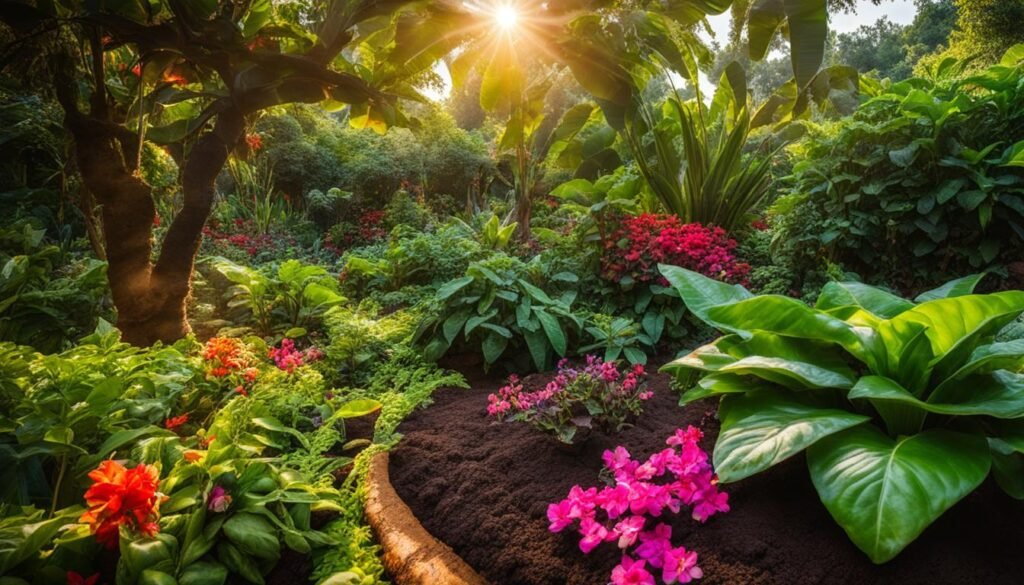
Coffee grounds can be a beneficial addition to your garden, providing nutrients and enriching the soil for certain plants. Here are some plants that thrive with coffee grounds:
- Carrots
- Eggplants
- Potatoes
- Parsley
- Peppers
- Radishes
- Blueberries
- Strawberries
- Avocado trees
- Citrus trees
- Mango trees
- Pineapples
- African violets
- Azaleas
- Hydrangeas
These plants benefit from the nitrogen, potassium, and other nutrients found in coffee grounds, which can contribute to their growth and overall health.
Table: Plants That Thrive with Coffee Grounds
| Plant | Nutrient Benefits |
|---|---|
| Carrots | Improved root development and vigor |
| Eggplants | Enhanced fruit production and flavor |
| Potatoes | Increased tuber formation and yield |
| Parsley | Stronger foliage growth and aroma |
| Peppers | Improved flowering and fruiting |
| Radishes | Faster germination and larger roots |
| Blueberries | Acidic soil enrichment and healthy growth |
| Strawberries | Increased fruiting and disease resistance |
| Avocado trees | Stronger root development and foliage growth |
| Citrus trees | Enhanced fruit production and vitality |
| Mango trees | Improved flowering and fruit set |
| Pineapples | Greater nutrient uptake and sweeter fruit |
| African violets | Lush foliage and vibrant flower blooms |
| Azaleas | Healthy growth and abundant flowering |
| Hydrangeas | Enhanced bloom color and size |
By incorporating coffee grounds into the soil or using them as mulch, you can provide these plants with the extra nutrients they need for optimal growth. However, remember to use coffee grounds in moderation and consider the specific needs of each plant to avoid over-fertilization.
How to Use Coffee Grounds for Plants
Using coffee grounds in your garden can provide numerous benefits for plant growth and soil health. Here are some different ways you can use coffee grounds to maximize their potential:
1. Composting:
Add coffee grounds to your compost pile to enhance its nutrient content. Coffee grounds are rich in nitrogen, which is essential for healthy plant growth. Mix them with other organic matter, such as vegetable scraps, leaves, and grass clippings, to create a well-balanced compost. This nutrient-rich compost can be used as a natural fertilizer for your plants.
2. Liquid Fertilizer:
You can also make a liquid fertilizer using coffee grounds. Simply steep the coffee grounds in water for a few days, then strain the liquid. Dilute the mixture with water and use it to water your plants. This homemade fertilizer is a cost-effective and eco-friendly way to provide your plants with essential nutrients.
3. Mulching:
Spread a layer of coffee grounds around the base of your plants as a mulch. Coffee grounds act as a natural barrier, helping to retain moisture in the soil, prevent weed growth, and regulate soil temperature. This can create a favorable environment for plant growth while reducing the need for additional watering and weeding.
4. Pest Repellent:
Coffee grounds can also be used to repel certain pests in your garden. Sprinkle coffee grounds around the perimeter of your plant beds to deter slugs and snails, which dislike the texture and aroma of coffee grounds. This natural method can help protect your plants from these common garden pests.
| Benefit | Method |
|---|---|
| Nutrient-rich soil | Composting |
| Essential nutrients | Liquid fertilizer |
| Moisture retention | Mulching |
| Pest repellent | Pest Repellent |
When Coffee Grounds Don’t Work for Plants
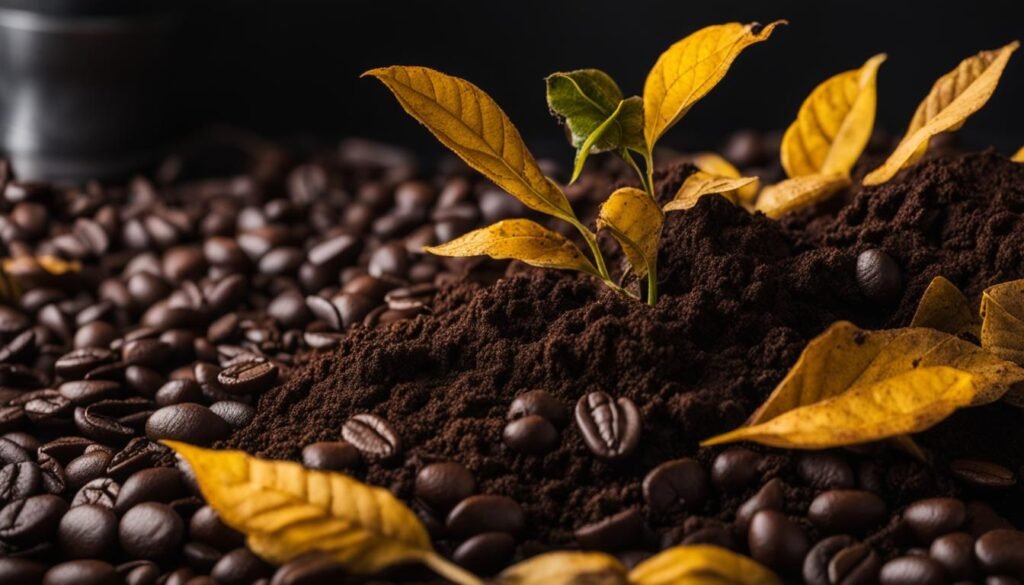
Coffee grounds are generally beneficial for plants, but there are a few instances where they may not be suitable. One factor to consider is the caffeine content in coffee grounds, which can suppress plant growth, especially when used in high concentrations. The caffeine acts as a natural plant growth inhibitor, affecting the germination and development of certain plants. So, if you notice stunted growth or yellowing leaves, it could be a sign that the caffeine in coffee grounds is negatively impacting your plants.
Another consideration is the phytotoxicity of fresh coffee grounds. When coffee grounds are fresh, they contain high levels of acidity. This acidity can be harmful to seedlings and young plants, causing damage to their roots and inhibiting their growth. It’s important to allow coffee grounds to age or decompose before using them near delicate plants to avoid any potential harm.
Despite these limitations, coffee grounds can still be beneficial for most plants when used properly. By using them in moderation and ensuring that they have aged or decomposed, you can mitigate the negative effects of caffeine and fresh acidity. Additionally, it’s always a good idea to observe your plants’ reactions when using coffee grounds and adjust your gardening practices accordingly.
| Issue | Solution |
|---|---|
| Caffeine in coffee grounds suppresses plant growth | Use coffee grounds in moderation and dilute them with other organic matter |
| Fresh coffee grounds are phytotoxic | Allow coffee grounds to age or decompose before using them near seedlings and young plants |
What to Do If Your Plants Are Affected?
If you notice signs of suppressed growth or phytotoxicity in your plants after using coffee grounds, there are a few steps you can take to mitigate the issue. First, stop using coffee grounds on the affected plants and replace them with a different organic fertilizer. Next, adjust the soil pH by adding lime or wood ash to neutralize the acidity from the coffee grounds. Finally, monitor the affected plants closely and provide them with proper care to help them recover.
The Benefits of Coffee Grounds for Soil
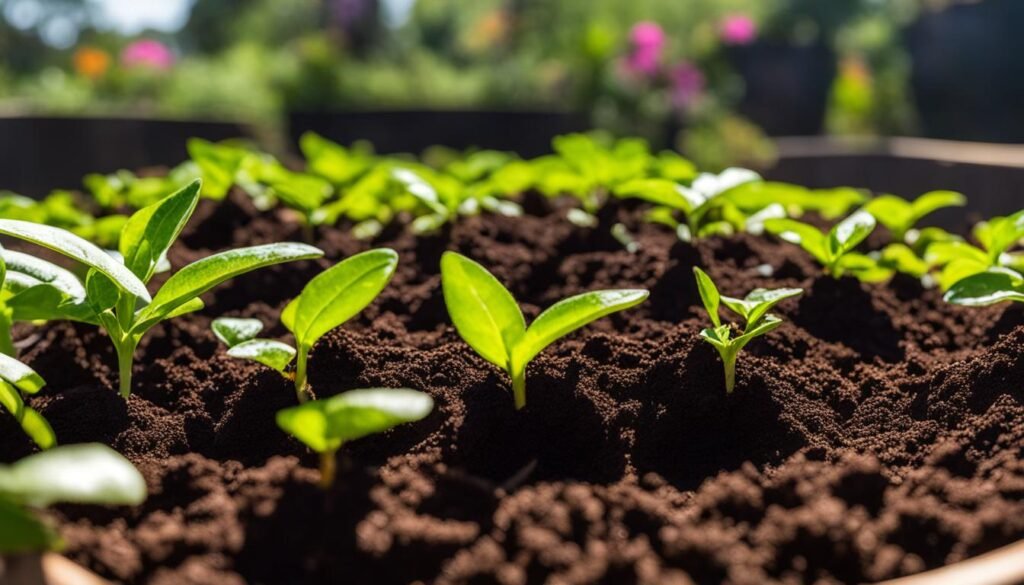
Coffee grounds are not only beneficial for plants, but they also have a positive impact on the soil in your garden. Here are some of the key benefits of using coffee grounds as a natural fertilizer:
Improved Soil Trace Mineral Content
Coffee grounds are rich in essential minerals like nitrogen, potassium, and phosphorus. When added to the soil, these minerals help replenish nutrient levels, promoting healthy plant growth. The organic matter in coffee grounds also acts as a long-term source of nutrients, gradually releasing them into the soil over time.
Enhanced Soil Structure and Composition
The organic matter in coffee grounds helps improve soil structure and composition. It increases the soil’s ability to retain moisture, which is crucial for plant growth. Coffee grounds also act as a natural soil conditioner, making the soil more friable and easier for roots to penetrate.
Increased Soil Water Retention
One of the key benefits of coffee grounds is their ability to improve soil water retention. The organic matter in coffee grounds acts like a sponge, absorbing and holding onto moisture. This is particularly important in dry or arid regions where water conservation is essential for successful gardening.
Overall, incorporating coffee grounds into your garden soil can provide numerous benefits, including improved trace mineral content, enhanced soil structure, and increased water retention. By recycling your coffee grounds and using them as a natural fertilizer, you can promote the health and vitality of both your plants and the soil they grow in.
Other Uses for Coffee Grounds in the Garden
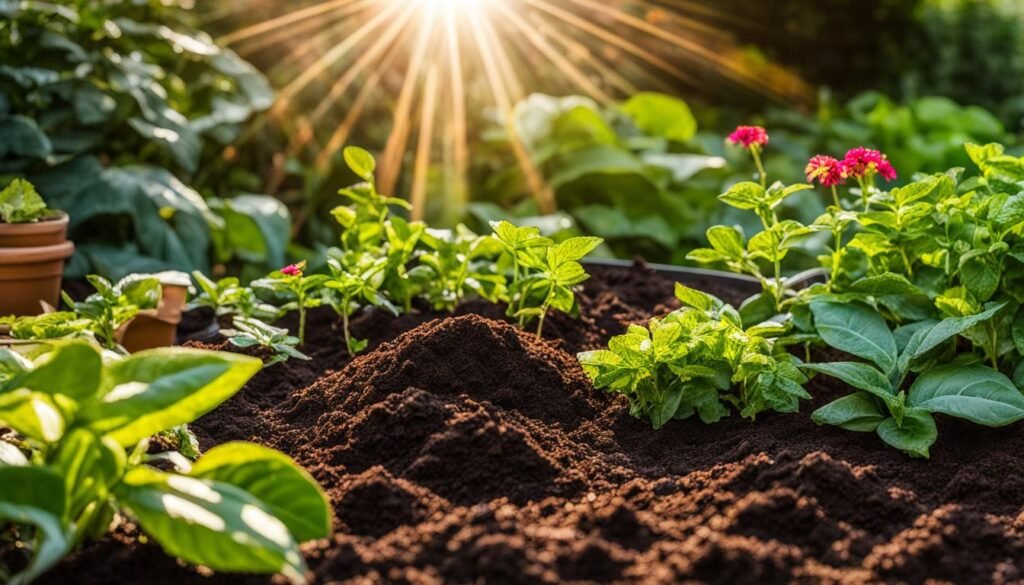
Coffee grounds have a wide range of uses in the garden beyond just fertilizing plants. Here are some other ways you can make the most of your spent coffee grounds:
1. Prevent Pathogenic Fungi
Certain plants, such as tomatoes and roses, are susceptible to fungal diseases like powdery mildew. Sprinkling coffee grounds around the base of these plants can help inhibit the growth of pathogenic fungi, keeping your plants healthy and disease-free.
2. Improve Water Retention
Coffee grounds have the ability to absorb and retain moisture, making them an excellent addition to soil for plants that require a higher level of hydration. Mixing coffee grounds with potting soil or adding them to raised beds can help improve water retention and reduce the frequency of watering.
3. Repel Pests
Coffee grounds can act as a natural deterrent for certain pests in the garden. Sprinkling coffee grounds around your plants can help keep away bees, wasps, fleas, and mosquitoes. These pests are often repelled by the strong aroma of coffee grounds, making them less likely to visit your garden.
4. Soil Amendment
In addition to being a great fertilizer, coffee grounds can also be used as a soil amendment. They can help improve soil structure, enhance drainage, and increase the overall nutrient content of the soil. Mixing coffee grounds with other compost materials can create a well-balanced soil amendment for your garden.
With these additional uses, coffee grounds can become a multipurpose tool in your gardening arsenal. Whether you’re preventing diseases, improving water retention, repelling pests, or enriching your soil, coffee grounds offer a range of benefits beyond their fertilizing properties.
Tips for Using Coffee Grounds in Your Garden

When it comes to using coffee grounds as fertilizer in your garden, there are a few important tips to keep in mind. By following these guidelines, you can maximize the benefits of coffee grounds for your plants while avoiding any potential issues.
1. Use coffee grounds in moderation:
While coffee grounds are a great source of nutrients for plants, it’s important not to overdo it. Using too much coffee grounds at once can lead to nutrient imbalances and potentially harm your plants. Instead, sprinkle a thin layer of coffee grounds around the base of your plants and mix it into the soil. Gradually increase the amount over time as your plants adjust.
2. Consider the pH requirements of your plants:
Coffee grounds are slightly acidic, so it’s essential to consider the pH requirements of your plants. Acid-loving plants like azaleas, blueberries, and rhododendrons will benefit from the acidic nature of coffee grounds. However, if you have plants that prefer alkaline soil, such as clematis or lilacs, it’s best to avoid using coffee grounds or use them sparingly.
3. Mix coffee grounds with other compost materials:
For optimal results, mix coffee grounds with other compost materials before incorporating them into the soil. This helps to maintain a balanced nutrient profile and ensures that the coffee grounds are evenly distributed throughout the soil. You can add coffee grounds to your compost pile or mix them with other organic matter like leaves, grass clippings, or vegetable scraps.
Remember, coffee grounds should be used as a supplement to other fertilizers and soil amendments. They are not a standalone solution for plant nutrition. By using coffee grounds responsibly and in conjunction with other gardening practices, you can harness their potential benefits and watch your garden thrive.
| Benefits of Using Coffee Grounds in Your Garden | Tips for Using Coffee Grounds |
|---|---|
| 1. Improve soil fertility | 1. Use coffee grounds in moderation |
| 2. Enhance soil structure and composition | 2. Consider the pH requirements of your plants |
| 3. Increase soil water retention | 3. Mix coffee grounds with other compost materials |
| 4. Bind harmful chemicals and pesticide residues | |
| 5. Provide organic matter and nutrients to the soil |
Conclusion
As gardeners, we are always looking for ways to provide the best care for our plants. Coffee grounds can be a valuable resource in achieving that goal. By utilizing coffee grounds in our gardens, we can provide essential nutrients, improve soil health, and help our plants thrive.
It’s important to know which plants love coffee grounds and how to use them properly. By understanding the specific needs of our plants, we can ensure that we are enhancing their growth and vitality. Remember to use coffee grounds in moderation, as excessive amounts can lead to nutrient imbalances and soil compaction.
When incorporating coffee grounds into our gardening routines, it’s crucial to consider the individual pH requirements of our plants. Coffee grounds are slightly acidic, so it’s important to monitor the acidity of our soil to avoid any negative effects. Mixing coffee grounds with other compost materials and gradually incorporating them into the soil is the best approach.
So, let’s take advantage of the benefits coffee grounds offer. They are a natural and organic way to provide nutrients, improve soil health, and boost the success of our plants. With proper knowledge and application, we can create a thriving garden that brings us joy and beauty.
FAQ
What are coffee grounds?
Coffee grounds are the leftover grounds from brewing coffee. They contain nitrogen, potassium, phosphorus, and various micronutrients that benefit plant growth.
How do coffee grounds benefit plants?
Coffee grounds are a rich source of nitrogen, improve soil trace mineral content, enhance soil structure and composition, and boost soil water retention. They can also bind harmful chemicals and pesticide residues in the soil, preventing pollution of the surrounding environment.
Which plants like coffee grounds?
Some plants that love coffee grounds include carrots, eggplants, potatoes, parsley, peppers, radishes, blueberries, strawberries, avocado trees, citrus trees, mango trees, pineapples, African violets, azaleas, and hydrangeas.
How can I use coffee grounds for plants?
Coffee grounds can be added to compost, used to make a liquid fertilizer, used as mulch, or to repel pests like slugs. They can be used to prevent pathogenic fungi, improve water retention, and repel certain pests like bees, wasps, fleas, and mosquitoes.
Are there plants that coffee grounds don’t work for?
Yes, the caffeine content in coffee grounds can suppress plant growth, especially in high concentrations. Additionally, fresh coffee grounds can be phytotoxic and harm seedlings and young plants.
What are the benefits of coffee grounds for soil?
Coffee grounds improve soil trace mineral content, enhance soil structure and composition, and increase soil water retention. They can also bind harmful chemicals and pesticide residues in the soil, preventing pollution of the surrounding environment.
Can coffee grounds be used for anything else in the garden?
Yes, coffee grounds can be used to make a liquid fertilizer, repel pests, or even deter cats from your garden. They can also be used as a soil amendment or mixed with other compost materials to provide organic matter and nutrients to the soil.
Any tips for using coffee grounds in my garden?
When using coffee grounds, avoid using too much at once, as it can cause nutrient imbalances and compact the soil. It’s also crucial to consider the pH requirements of your plants, as coffee grounds can be slightly acidic. Mixing coffee grounds with other compost materials and gradually incorporating them into the soil is the best approach.
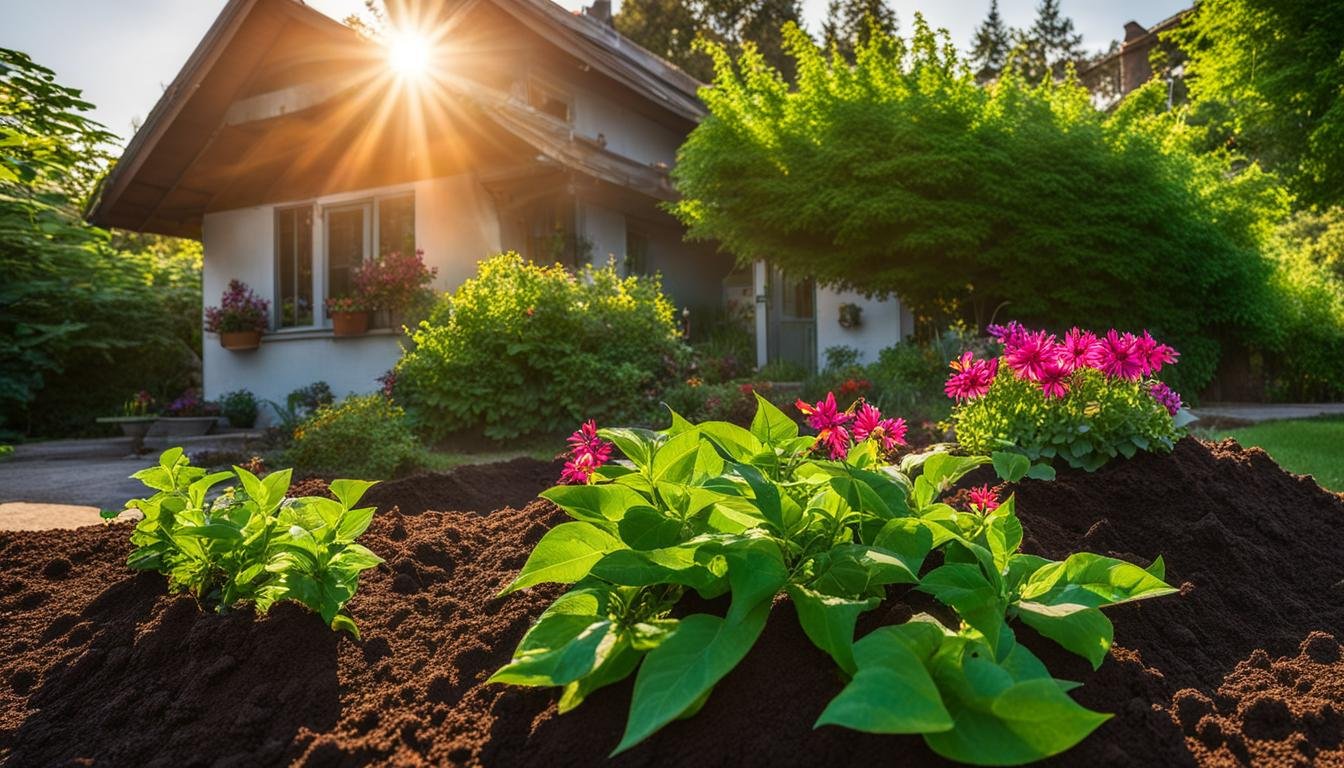
Leave a Reply